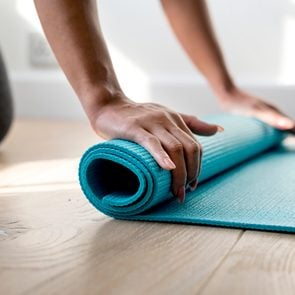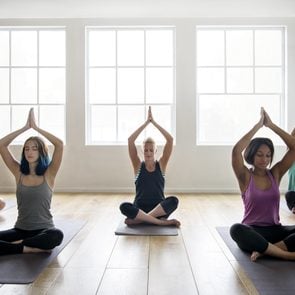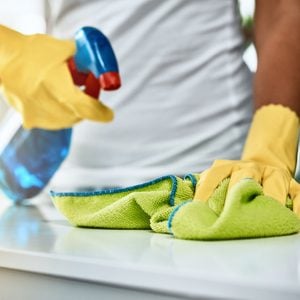How To Clean Your Yoga Mat—and the Major Reason You Should
Updated: Mar. 20, 2023
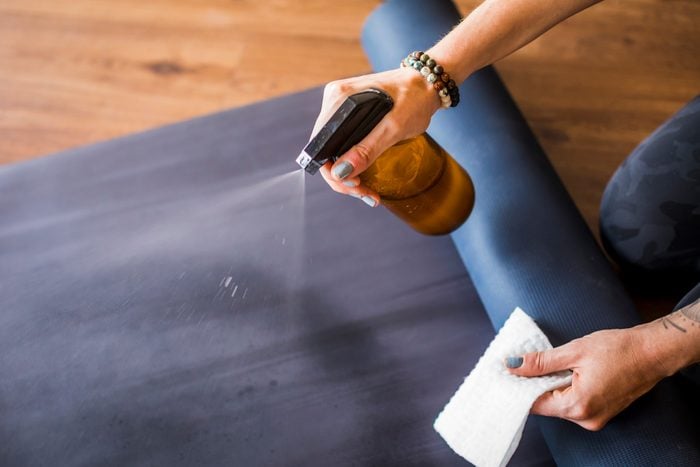
One yoga practitioner's story of infection illustrates how important hygiene mindfulness is before you step onto your yoga mat.
Our editors and experts handpick every product we feature. We may earn a commission from your purchases.
How to clean your yoga mat
There are so many health benefits of yoga, and the last thing we’d aim to do is give you a single reason not to do it. However, while the COVID-19 pandemic taught us a lot about better cleaning—hand washing to disinfecting your phone to air purifying—in many cases, we forgot about the other viruses and bacteria we can contract just from our usual routines. The truth is, your yoga mat is one spot that might be harboring some serious growth.
Juthika Thakur, MD, a board-certified dermatologist in Canada, explains: “Staphylococcus and streptococcus infections are the most common infections you can catch from a yoga mat.” You read that right: Strep- and staph-related bacteria can often be found on a yoga mat.
When you think about it, every time you touch your hands to the mat then brush a strand of hair from your face, you’re transferring germs from the floor, your feet, and it’s hard to know what else, right to your face. The risk is even worse if you have an open wound, such as an acne sore or a dreaded cut from the pedicure chair—and next, this yoga practitioner’s story illustrates what can happen in the worst of cases.
Epidemiologists’ Top 12 Gym Hygiene Rules Since the Pandemic
Contracting an infection from a gym yoga mat
“I got cellulitis on my hand from a yoga mat,” says Jess P., 36, of Denver. How she contracted this bacterial skin infection? Jess had a small cut on her finger that she’d forgotten to cover with a bandage before she attended her regular hot yoga class. She used a yoga mat the studio provided, placing her bare hands and feet on it.
Soon after class, she noticed that the spot had become painful and swollen. She had washed it with soap and water, but within hours it was throbbing. By bedtime, the redness had moved up past her knuckle and onto her hand; by morning, it was up to her wrist. She called her doctor, who told her to go to urgent care immediately.
“The pain was almost unbearable by that point, and I couldn’t close my hand at all,” she says. “I couldn’t believe it had escalated so quickly.”
Her cellulitis diagnosis likely stemmed from bacteria on the studio yoga mat that got into the cut on her finger. It took two different antibiotics and nearly a month before the infection had cleared up. If the second antibiotic hadn’t worked, she was told she would need surgery to remove the infected area.
Jess’s story is one extreme case that fortunately ended well—but the moral of her story is simple: You should wipe your yoga mat down after every use and do a deeper clean once a week. (And if you’re not using your own mat, you’ll want to consider a good wipe-down before you use it, too.) “Anyone with an open cut should be careful and take extra precautions,” says Dr. Thakur, “but overall the risk of contracting a serious infection from a yoga mat is minimal.”
If you’ve been previously diagnosed with a skin infection, like MRSA or a fungal infection, she recommends clean your mat more frequently to avoid reinfection. “I also recommend wearing your own slippers or socks to walk around the studio before taking them off for your yoga session,” Dr. Thakur says. (Our Reader’s Digest team has recommended the best slippers for women and men.)
Get The Healthy @Reader’s Digest newsletter
Yoga mats: A possible breeding ground for germs
The combination of bare feet and the moisture from your sweat and the studio create the perfect environment for fungi, viruses, and bacteria to thrive. Says nurse Maria Striemer, RN, these are the same bacteria that can cause skin conditions like rashes, plantar warts, ringworm, impetigo, and athlete’s foot among others. (As the senior scientific communications manager at Procter & Gamble’s P&G Home Care, Striemer is well-versed in seeing community-acquired infections.)
Here’s How Long You Should Hold a Yoga Pose, Says a 50-Year Expert
What the science says
For a 2014 study published in the International Journal of Environmental Research and Public Health, researchers swabbed a variety of surfaces, including floor mats, at four different 24-hour gyms in the United States. Gym surfaces and equipment were covered in bacteria: Salmonella, Staphylococcus, Klebsiella, and Micrococcus bacteria, with Staphylococcus being the most prevalent. These aren’t bugs you want to mess around with: A staph infection is annoying at best, and in some cases can even be deadly.
Beyond germs, you also need to be aware of environmental contaminants, like dirt, dust, pet hair, and even fecal matter tracked in on shoes or unwashed hands, says Natalie Barrett, a quality supervisor for specialty fabrics like fitness flooring and yoga mats. These can carry germs or cause reactions, including allergies.
A Bone Health Doctor Just Listed the 12 Best Yoga Poses to Strengthen Bones
Disinfecting your yoga mat
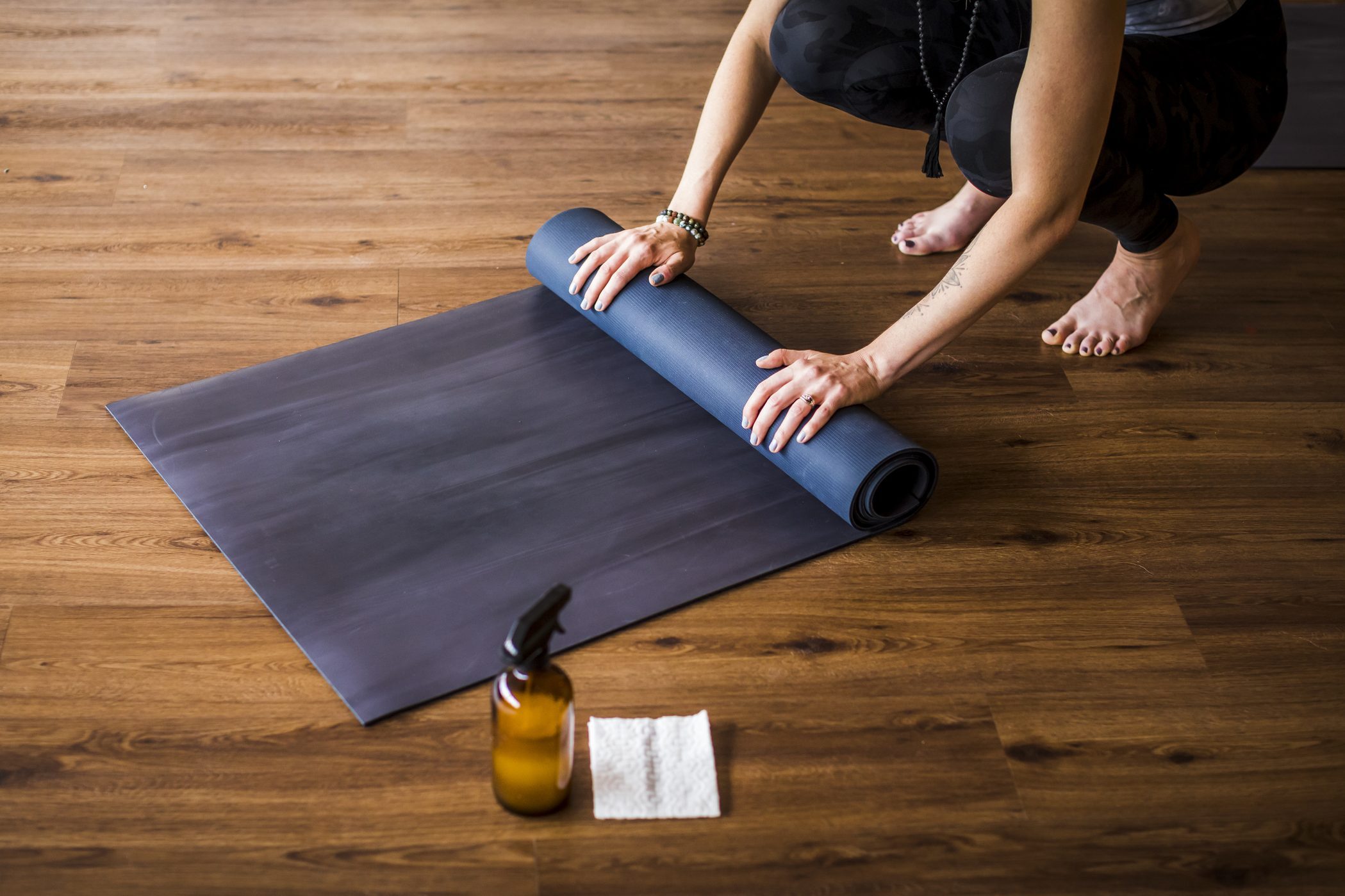
When it comes to caring for your mat, you need to both disinfect it (to kill bacteria, viruses, and fungi) and clean it (to remove dirt, debris, fluids, hair, and stains). If you borrow mats from your gym or studio, you should clean your mat before and after you use it, just to be safe. This is just one of the secrets that yoga instructors wish you knew. In the International Journal of Environmental Research and Public Health study, researchers pointed to a lack of cleanliness on the part of gyms as one reason so many surfaces were covered in bacteria.
You should be disinfecting your yoga mat after each use, and it doesn’t need to be complicated. “To clean your mat, a simple solution with a mixture of white vinegar and water in a spritzer bottle will do the trick,” Dr. Thakur says. “Let it sit for a couple of minutes and then wipe off with a soft, absorbent cloth.”
If you don’t love the smell of pure vinegar, Maker suggests adding 20 drops of tea tree or lavender essential oils.
Dr. Thakur points out that you should be sure to follow the manufacturer’s instructions on how to clean your mat effectively. Anything harsher than the brand’s recommendations “could possibly damage your mat and maybe even cause a skin reaction, something we call contact dermatitis,” Dr. Thakur says. “All to say, skin is incredibly tough,” she says, “but take the regular measures to maintain your skin barrier with diligent moisturizer use, and don’t let a few microbes get in the way of a good stretch!”
If your gym provides a harsher cleaning product than you want to use, cleaning expert Joseph Marini of At Home With Joseph offers an added tip. “If you bring your own yoga mat to a studio for a class, consider also bringing a clean microfiber cloth in a Ziplock bag that has been saturated with a 50/50 vinegar/water solution to wipe your mat down.”
Is “Fly Yoga” Worth It? Science Says It May Yield 6 Major Health Benefits
How to deep-clean your yoga mat
Marini recommends giving your yoga mat a deep cleaning at least once a month using a good quality dish soap. “I like to use Dawn, as it cuts through tough dirt and stains easily,” Marini says. We recommend a product that specifies its anti-bacterial power.
- If you have a bathtub, fill it with three inches of hot water and enough Dawn to create suds.
- Submerge the yoga mat, and allow it to soak on each side for a good minute or two.
- Using a sponge, wipe both sides of the mat in a circular motion while in the soapy water.
- Drain the water and rinse the mat under the faucet.
- Dry the mat immediately by placing it over the shower curtain, a drying rack, or a clothesline.
- Consider using a hairdryer on a medium setting to dry both sides of the mat quickly.
For those who have only a shower:
- Simply fill a clean bucket with hot water and Dawn.
- Wet the yoga mat with the sudsy water, and wipe it down with a sponge.
- Repeat two or three times, and then rinse the mat under the showerhead.
- Dry in the same manner.
“Keep in mind that after prolonged use a yoga mat might accumulate permanent stains and you should never use the scouring side of a sponge to try to get the stains out,” Marini says. “This would only serve to damage the mat over time.”
The 5 Best Yoga Poses for a Healthier Gut, from a Registered Yoga Teacher
Pro tips for keeping your yoga mat clean
There are a few other pointers you can follow to keep your mat clean between washings and reduce the risk of germs, according to our experts:
-
Let it air out. Don’t roll your mat up immediately after cleaning. Damp sweat and even residual cleaning spray can provide a breeding ground for bacteria, so let your mat hang in your home or in a shady spot outdoors.
-
Keep it out of direct sunlight. Prolonged exposure to heat or the sun can damage your mat and lead to cracks, and damaged mats are more likely to breed germs and gather dirt.
-
Fold it in half before rolling. Bring the bottom of your mat up to the top, so the yoga surface is only touching itself, then roll the folded mat from the bottom up. This way the floor side is never in contact with the yoga side.
-
Use a carrying bag. Store and carry your yoga mat in a breathable tote rather than using a strap or your hands.
“The art of practicing yoga can help provide peace to your mind, body, and soul,” says Striemer. Regularly giving your mat a cleaning will help your peace of mind.
- One Major Health Effect Of Working Under Overhead Lights
- Can You Get Vitamin D Through a Window? Doctors Explain
- How To Relax Your Mind
- What Is a ‘Slow Morning’? Here’s How To Have One
Additional writing and reporting by Jaime Stathis.

